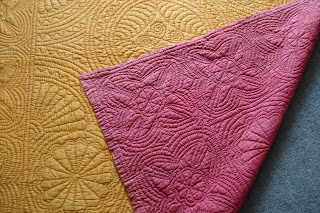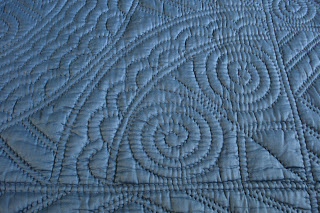




Here is a Welsh quilt which has a jaunty feel to it - and it is one of my particular favourites because of its lively air. Originally sold at an auction house at Four Hands, Llanelli, it is local to that area. The dealer had seen other, similar quilts, in a similar colour combination, in that area.
The quilt measures 66 x 74 inches and has been well used, but is still in good condition. One side is a mid gold colour cotton sateen, the other a rich pink colour. The quilting thread is gold. The quilt edge is neatly hand sewn.
The quilting designs are very pleasing on this quilt. There is a central medallion of beech leaves, surrounded by circles and spirals; there are fans and large daisies and a lively four lobed flower design. Multiple outlines add energy to the whole. The wadding is carded lambswool and the stitching assured. This quilt was undoubtedly made by a local quilter using designs traditional to that area.
A limited number of templates have been used to great effect, with outlining adding a great amount of energy. The quilt is in very vivid colours (the photos here look a bit subdued compared to the actual quilt). It just proves that in quilting, simple designs are often the most effective, especially if arranged skillfully and, in the Welsh tradition, outlined for additional emphasis. Welsh quilting at its best.










































